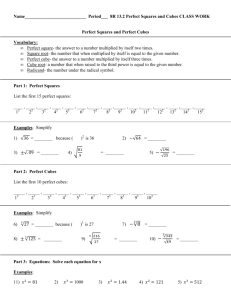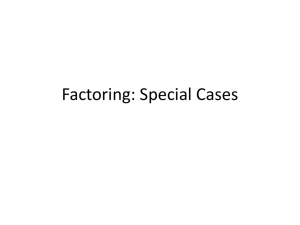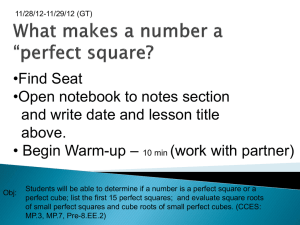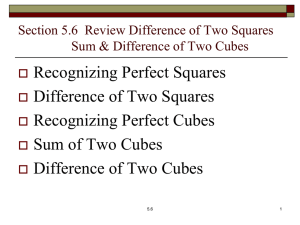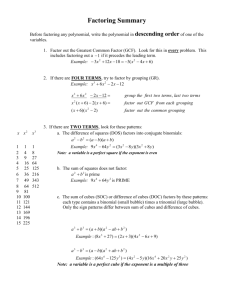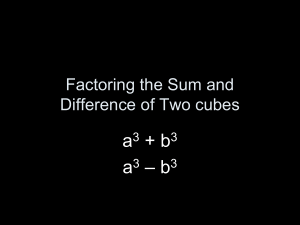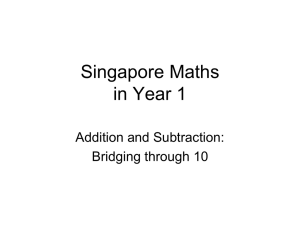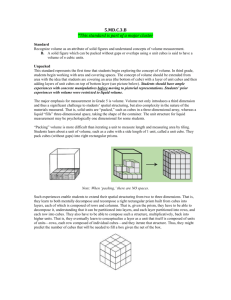Show that the sum of the cubes of the first n natural numbers equal
advertisement
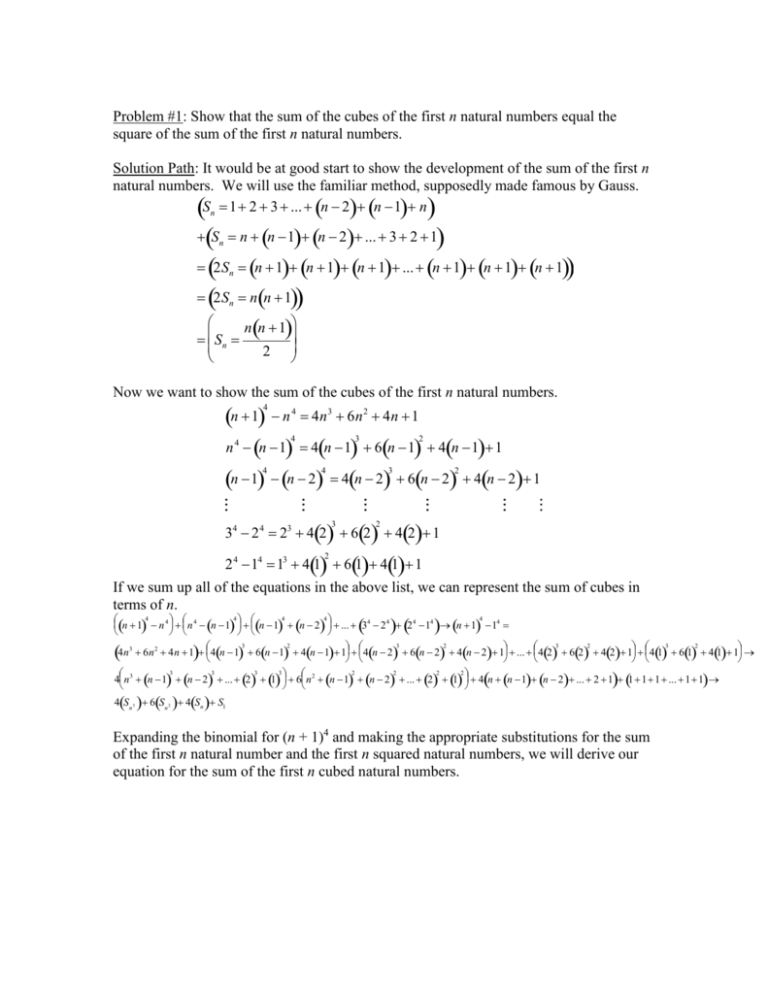
Problem #1: Show that the sum of the cubes of the first n natural numbers equal the square of the sum of the first n natural numbers. Solution Path: It would be at good start to show the development of the sum of the first n natural numbers. We will use the familiar method, supposedly made famous by Gauss. Sn 1 2 3 ... n 2 n 1 n S n n 1 n 2 ... 3 2 1 2S n 1 n 1 n 1 ... n 1 n 1 n 1 2S nn 1 n n n n n 1 S n 2 Now we want to show the sum of the cubes of the first n natural numbers. n 1 n 4n 6n 4n 1 n n 1 4n 1 6n 1 4n 1 1 n 1 n 2 4n 2 6n 2 4n 2 1 4 4 3 4 4 4 2 3 2 4 3 2 34 2 4 23 42 62 42 1 3 2 2 4 14 13 4 1 6 1 4 1 1 2 If we sum up all of the equations in the above list, we can represent the sum of cubes in terms of n. 4 4 4 4 4 n 1 n 4 n 4 n 1 n 1 n 2 ... 34 2 4 2 4 14 n 1 14 3 2 3 2 2 2 3 3 4n 3 6n 2 4n 1 4n 1 6n 1 4n 1 1 4n 2 6n 2 4n 2 1 ... 42 62 42 1 4 1 6 1 4 1 1 3 3 3 3 2 2 2 2 4n 3 n 1 n 2 ... 2 1 6n 2 n 1 n 2 ... 2 1 4 n n 1 n 2 ... 2 1 1 1 1 ... 1 1 4Sn 3 6Sn 2 4Sn S1 Expanding the binomial for (n + 1)4 and making the appropriate substitutions for the sum of the first n natural number and the first n squared natural numbers, we will derive our equation for the sum of the first n cubed natural numbers. n 1 1 4 4 4Sn 3 6Sn 2 4Sn S1 nn 12n 1 nn 1 4 n 4n 6n 4n 11 4Sn 3 6 2 n 6 4 3 2 n 4 4n 3 6n 2 4n 4Sn 3 2n 3 3n 2 n 2n 2 2n n n 4 2n 3 n 2 4Sn 3 n 2 n 1 2 Sn 3 4 If we take our expression for the sum of the first n natural numbers and square the expression, we should get this last expression. nn 1 Sn 2 n n 12 n 2 n 12 2 Sn 2 4 Sn3 Thus the square of the first n natural numbers equals the sum of the cubes of the first n natural numbers. Problem #2: Develop a sum for the first four powers of the first n natural numbers. Solution Path: We have shown the sum of the first n natural numbers and the sum of the cubes of the first n natural numbers in an earlier problem. At this moment, we will find the formula for the sum of the squares of the first n natural numbers and the formula for the sum of the fourth powers of the first n natural numbers, with the hopes of finding a closed form for the sum of any natural number power of the first n natural numbers. First we will find the sum of the squares of the first n natural numbers. To do this, we will refer to the squares of natural numbers in terms of the cubes of those natural numbers. n 1 n 3n 3n 1 n n 1 3n 1 3n 1 1 n 1 n 2 3n 2 3n 2 1 3 3 2 3 3 2 3 3 33 23 32 32 1 2 23 13 3 1 3 1 1 2 2 At this point, we will add up these equations together. By doing so, we can refer to the sum of the squares of the first n natural numbers in terms of the sum of the first n natural numbers and n. n 1 n 3 3 n 3 n 1 n 1 n 2 3 3 3 33 23 23 13 n 1 13 3 3n 2 3n 1 3n 1 3n 1 1 3n 2 3n 2 1 32 32 1 3 1 3 1 1 2 2 2 2 2 2 2 3n 2 n 1 n 2 ...2 1 3 n n 1 n 2 2 2 1 1 1 1 3Sn 2 3Sn n We will use these expressions to solve for the sum of the squares of the first n natural numbers. We will confirm the result of the sum of the first n natural numbers in a subsequent problem. n 1 1 3 3 3Sn 2 3Sn n n n 1 n 3n 3n 11 3Sn 2 3 2 n 3 2 3 1 n 3 n 2 n 3Sn 2 2 2 1 3 1 2 1 n n n Sn 2 3 2 6 n n 12n 1 Sn 2 6 Now we will try to develop a pattern for the sum of the fourth powers of the first n natural numbers. We will use the same format as determining the sum of the squares. 5 n 1 n5 5n 4 10n3 10n2 5n 1 n 5 n 1 5n 1 10n 1 10n 1 5n 1 1 5 4 3 2 n 1 n 2 5n 2 10n 2 10n 2 5n 2 1 5 5 4 3 35 25 52 102 102 52 1 4 3 2 25 15 5 1 10 1 10 1 5 1 1 4 3 2 Adding the above equations will yield the desired result: 2 1 1 n 1 n 5 5 n 5 n 1 n 1 n 2 5 5 35 25 25 15 n 1 15 5 5 5n 4 10n 3 10n 2 5n 1 5n 1 10n 1 10n 1 5n 1 1 4 3 5n 2 10n 2 10n 2 5n 2 1 4 3 2 2 52 102 102 52 1 5 1 10 1 10 1 5 1 1 4 3 2 4 3 2 4 4 3 3 2 2 5n 4 n 1 n 2 ... 2 4 14 10n 3 n 1 n 2 ... 23 13 10n 2 n 1 n 2 ... 22 12 5 n n 1 n 2 ... 2 1 1 1 1 1 1 5Sn 4 10Sn 3 10Sn 2 5Sn n 1 2 2 n n 12n 1 n n 1 n n 1 5 n 1 1 5Sn4 10 4 10 2 n 6 5 5 n 5 5n 4 10n 3 10n 2 5n 5 5 5 5 n 5 n 4 n 3 n 2 n 5Sn 4 2 3 2 3 5 4 5 5 n 2n 3 n 2 2n 3 3n 2 n n 2 n n 5Sn 4 2 3 2
